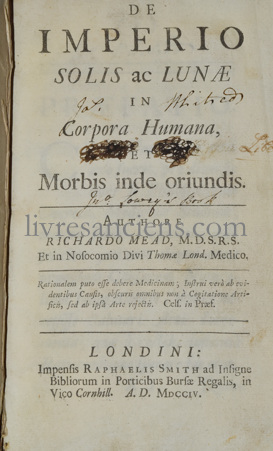

MEAD, De Imperio Solis ac Lunae, 1704

MEAD, Richard.
De Imperio Solis ac Lunae in corpora Humana et Morbis inde oriundis.
Londres, Raphael Smith, 1704.
Un volume in-8 (192x117 mm), (2)-xxx-96 pages. reliure : Plein veau de l'époque, dos à cinq nerfs orné et doré. Reliure anglaise dans le style de Cambridge, plats estampés à froid. Petits manques de cuir. Manque la première garde blanche.

Édition originale.
Richard Mead (1673-1754), médecin et ami d’Isaac Newton, tente dans ce livre de montrer l’influence des forces gravitationnelles sur la santé humaine.
Mesmer s’inspirera fortement de ce livre pour écrire sa thèse de doctorat en 1766 (De l’influence des planètes sur le corps humain). Le terme de "gravitation animale" pris chez Mead sera plus tard changé par Mesmer en "Magnétisme animal".
références: Garrison-Morton [10160 : "Mead formulated the position that periodic atmospheric tides arising from planetary forces produced alterations of gravity, elasticity, and air pressure; these changes, he argued, affected the human body in health and disease. Mesmer’s dissertation, which originated animal magnetism, was largely a plagiarism of Mead’s work.], Heirs of Hippocrates [768, (ed. 1739) : "On the influence of the sun and moon upon human bodies and the diseases thereby produced is Mead’s second book and was first published at London in 1704. During Mead’s day it was widely believed that celestial bodies had a direct influence on health; Mead attempts to explain this by employing the principles of Newtonian mechanics. Mead believed that atmospheric pressure was affected by the sun, moon, and stars, which produced changes similar to those of the oceanic tides. He also postulated that atmospheric variations in elasticity and pressure had a direct effect on the nervous fluid. Epilepsy, hysteria, menstrual disorders, nephritis, ulcers, and asthma were among the diseases that followed lunar cycles."].
Prix : 1500 €












